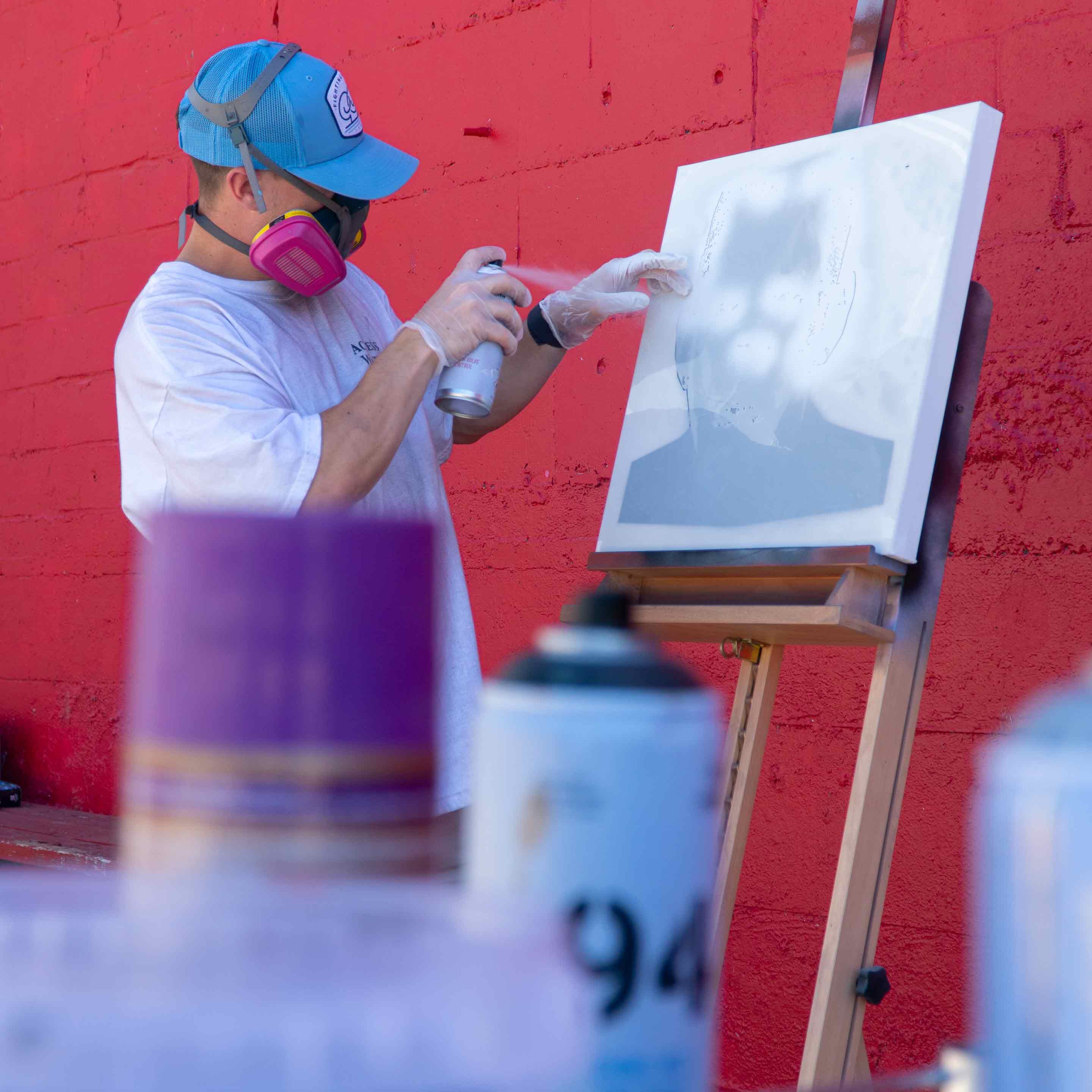Stop Paint Bleed and Create Crisp Stencil Lines Every Time
Paint bleed is the nemesis of clean stencil work. It happens when paint seeps underneath your stencil, creating fuzzy edges instead of crisp, professional lines. Whether you're working with spray paint or wall paint, this comprehensive guide will help you master the techniques that prevent bleed and create stunning results every time.
Understanding Paint Bleed
Paint bleed occurs when paint migrates underneath the stencil material, regardless of whether you're using liquid paint or spray paint. While it's impossible to eliminate completely, the right techniques can minimize it dramatically.
Key factors that affect paint bleed
- Surface texture: Smooth surfaces (glass, finished wood, smooth drywall) produce cleaner results than textured surfaces (rustic wood, concrete, stucco, brick)
- Stencil type: Adhesive stencils reduce bleed significantly compared to mylar or metal stencils
- Application technique: Proper paint application is crucial
- Paint quantity: Using too much paint is the #1 mistake beginners make
Choosing the Right Stencil
Adhesive Stencils: Your Best Defense
For the crispest lines possible, adhesive stencils are your best choice. These stencils feature a tacky backing that adheres directly to your painting surface, creating a seal that dramatically reduces paint seepage.
Pros:
- Significantly less paint bleed than mylar or metal stencils
- Excellent for uneven surfaces
- Creates the crispest lines
Cons:
- Designed for single-use (though they can be reused with care)
- More expensive per use
Pro tip: Adhesive stencils are particularly valuable when working on rough or uneven surfaces like brick walls, textured concrete, or weathered wood.
Spray Paint Techniques
Spray paint is one of the most popular choices for stenciling, but it requires a careful approach to avoid bleed.
Essential Spray Paint Tips
1. Secure Your Stencil Properly
Use painter's tape around all edges of the stencil to lock it in place. A stencil that doesn't move won't bleed. For mylar stencils, consider using adhesive spray (like Aleene's Crystal Clear Tacky Spray) on the backside for extra security. Clean afterwards with GooGone.
2. Master Your Distance and Technique
Spray from 10-15 inches away in short bursts. This is critical. Long, continuous sprays deposit too much paint at once, which is the primary cause of bleed.
The technique:
- Hold the can perpendicular to the surface
- Use quick, controlled bursts (1-2 seconds)
- Build up coverage gradually with multiple light passes
- Never try to achieve full coverage in one pass
3. Hold Down Loose Sections
Mylar stencils often won't lay completely flush, even on flat surfaces. Use a paint stirring stick, pencil, or wooden dowel to press down sections as you work. Move methodically, section by section, holding each area flat as you spray.
4. Spray from Edges Inward
Start at the outer edges of your design and work inward. This technique helps create crisp outer lines by directing paint away from the stencil's edges. Remember: short bursts always.
5. Layer from Outside to Inside
When using multi-layer stencil sets, always spray from the outside layers to the inside layers. This ensures proper alignment and the cleanest final result.
Wall Paint Techniques
Wall paint (latex, acrylic) requires different techniques than spray paint. Many beginners struggle with messiness and unclear lines, but these methods will transform your results.
Choosing the Right Applicator
Your choice of applicator is crucial:
Paint Roller:
- Use a dense foam roller or one with very low nap (the fuzzy texture)
- Avoid fluffy or high-nap rollers at all costs
- Dense rollers press the stencil down, creating crisp lines even on slightly uneven surfaces
Sponge:
- Great for small areas and detailed work
- Natural sea sponges or dense craft sponges work best
Paintbrush:
- Use for touch-ups and very detailed areas
- Choose stiff-bristled brushes over soft ones
Wall Paint Application Methods
1. Use Spray Adhesive
Just like with spray paint, adhesive spray secures the stencil to the wall. If you're creating a repeating pattern, reapply adhesive each time you reposition the stencil.
2. The "Dry Roller" Technique
This is the secret to clean lines with wall paint:
- Load your roller with paint
- Remove excess paint by rolling it on the paint tray's ridges
- Keep rolling until the roller appears almost dry
- Apply to the stencil with light, even pressure
It may take 3-4 passes to achieve solid coverage, and that's normal. Multiple light passes prevent bleed far better than one heavy pass.
Critical tip: Watch for paint pooling at the roller's edges. Thin out these pools by rolling on paper towel or rolling in place on the stencil before moving to a new section.
3. Dabbing with a Sponge
Never swipe or wipe when using a sponge. This drags paint underneath the stencil edges.
The correct technique:
- Load sponge with a small amount of paint
- Dab or bounce the sponge up and down on the surface
- Use a pouncing motion, perpendicular to the surface
- Build up coverage gradually
4. Circular Motion with Brushes
When using a paintbrush:
- Remove excess paint by wiping the brush on a paper towel
- Apply paint using circular motions (stippling works too)
- Never swipe across the stencil
- Take your time and use minimal paint
This circular motion prevents paint buildup under the stencil edges.
Universal Tips for All Projects
Before You Start
- Clean your surface thoroughly (dirt and dust create gaps)
- Ensure the surface is completely dry
- Test on scrap material first if possible
- Have touch-up paint ready
During Application
- Work in a well-lit area to spot potential issues
- Check edges periodically while working
- Remove the stencil carefully while paint is still wet (unless product directions say otherwise)
- Pull the stencil away slowly at a low angle
Touch-Ups and Fixes
Keep your original paint color handy for touch-ups. Don't be afraid to use a small detail brush to clean up edges. Most minor bleeding isn't visible from more than 2 feet away, so maintain perspective and don't stress over small imperfections.
Advanced Tips for Problem Surfaces
Rough or Textured Surfaces
- Always use adhesive stencils
- Consider a primer coat to smooth the surface slightly
- Accept that some imperfection is natural
- Apply extra adhesive spray if needed
Outdoor Projects
- Avoid windy days for spray paint
- Temperature matters: 50-85°F is ideal
- Watch for humidity (can affect drying and adhesion)
Large-Scale Projects
- Mark your stencil position with light pencil marks
- Use a level to ensure proper alignment
- Work systematically (left to right, top to bottom)
- Clean your stencil between positions
Troubleshooting Common Issues
Problem: Paint still bleeding despite following techniques
Solution: Use even less paint. Most beginners use 2-3x too much paint.
Problem: Stencil lifting during application
Solution: Add more painter's tape or adhesive spray. Press down firmly.
Problem: Design not coming through clearly
Solution: You're likely using too much paint at once. Do more passes with less paint per pass.
Problem: Stencil slipping during work
Solution: Clean the surface better before starting. Use more securing methods.
The Bottom Line
Preventing paint bleed comes down to three core principles:
- Secure your stencil completely (tape, adhesive, or adhesive stencils)
- Use less paint than you think you need (build up in light layers)
- Use the right application technique for your paint type
Remember: even professional stencilers get some minor bleed. The goal is crisp lines from normal viewing distance, not perfection under a magnifying glass. With practice and these techniques, you'll create stunning stencil art that looks professionally done.
Have questions? We're here to help! Happy stenciling!
Watch our video tutorial: How to Avoid Overspray for visual demonstrations of these techniques.




Leave a comment
This site is protected by hCaptcha and the hCaptcha Privacy Policy and Terms of Service apply.